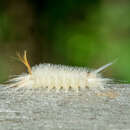fi
nimet breadcrumb-navigoinnissa


Halysidota harrisii, the sycamore tussock moth, is a moth of the family Erebidae and the tribe Arctiini, the tiger moths. The species was first described by Benjamin Dann Walsh in 1864.[1] It is found in southeastern Canada, the eastern parts of the United States, and northeastern Mexico.
The larvae have yellow-orange heads and bodies covered with hair, and they can grow to approximately 25–35 mm in length.[2][3] They exhibit two pairs of long, orange hair-pencils and two pairs of white hair-pencils towards the front of their body. They also exhibit one pair of white hair-pencils near the back of their body.
The adults are pale yellow with dark bands on the forewings.[2] Each forewing is 24–26 mm in length, making the wingspan approximately 50 mm.[4] As adults, they are almost indistinguishable from the closely related Halysidota tesselaris.[4]
The sycamore tussock moth produces two generations each year.[2] Moths emerge from overwintering cocoons from May to June.[2] After mating, they lay egg masses on bark and the underside of leaves. The larvae feed on the American sycamore tree, Platanus occidentalis.[2] They pupate in late June and July, and emerge as moths in July and August. The offspring of this generation spins cocoons in late September and October and overwinters as pupae.
An overpopulation of the insect can be damaging to sycamore trees. Natural predators, such as birds, control most populations. However, pesticides may be needed.[2]
The sycamore tussock moth caterpillar has been documented causing urticaria (hives).[5]
{{cite journal}}: Cite journal requires |journal= (help)  Caterpillar
Caterpillar Halysidota harrisii, the sycamore tussock moth, is a moth of the family Erebidae and the tribe Arctiini, the tiger moths. The species was first described by Benjamin Dann Walsh in 1864. It is found in southeastern Canada, the eastern parts of the United States, and northeastern Mexico.
Halysidota harrisii is een nachtvlinder uit de familie van de spinneruilen (Erebidae), onderfamilie beervlinders (Arctiinae). De soort wordt aangetroffen in het zuidoosten van Canada, het oosten van de Verenigde Staten (maar niet in Florida) en het noordoosten van Mexico.
De spanwijdte is ongeveer 50 mm. De vlinder vliegt in mei/juni en juli/augustus, afhankelijk van de plaats.
De rupsen gebruiken de westerse plataan (Platanus occidentalis) als waardplant.
Halysidota harrisii is een nachtvlinder uit de familie van de spinneruilen (Erebidae), onderfamilie beervlinders (Arctiinae). De soort wordt aangetroffen in het zuidoosten van Canada, het oosten van de Verenigde Staten (maar niet in Florida) en het noordoosten van Mexico.
De spanwijdte is ongeveer 50 mm. De vlinder vliegt in mei/juni en juli/augustus, afhankelijk van de plaats.
De rupsen gebruiken de westerse plataan (Platanus occidentalis) als waardplant.
Halysidota harrisii là một loài bướm đêm thuộc phân họ Arctiinae, họ Erebidae. Nó được tìm thấy ở đông nam Canada, khu vực miền đông của Hoa Kỳ (but not Florida) và đông bắc México.
Sải cánh dài khoảng 50 mm. Con trưởng thành bay từ tháng 5 đến tháng 6 và từ tháng 7 đến tháng 8 tùy theo địa điểm.
Ấu trùng ăn Platanus occidentalis.
Phương tiện liên quan tới Halysidota harrisii tại Wikimedia Commons
Halysidota harrisii là một loài bướm đêm thuộc phân họ Arctiinae, họ Erebidae. Nó được tìm thấy ở đông nam Canada, khu vực miền đông của Hoa Kỳ (but not Florida) và đông bắc México.
Sải cánh dài khoảng 50 mm. Con trưởng thành bay từ tháng 5 đến tháng 6 và từ tháng 7 đến tháng 8 tùy theo địa điểm.